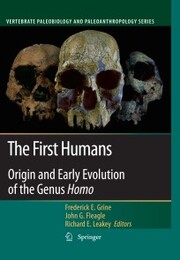Detailansicht
The First Humans
E-Book
Format: PDF
DRM: Digitales Wasserzeichen
- Zusatztext
- There are some issues in human paleontology that seem to be timeless. Most deal with the origin and early evolution of our own genus something about which we should care. Some of these issues pertain to taxonomy and systematics. How many species of Homo were there in the Pliocene and Pleistocene? How do we identify the earliest members the genus Homo? If there is more than one Plio-Pleistocene species, how do they relate to one another, and where and when did they evolve? Other issues relate to questions about body size, proportions and the functional adaptations of the locomotor skeleton. When did the human postcranial Bauplan evolve, and for what reasons? What behaviors (and what behavioral limitations) can be inferred from the postcranial bones that have been attributed to Homo habilis and Homo erectus? Still other issues relate to growth, development and life history strategies, and the biological and archeological evidence for diet and behavior in early Homo. It is often argued that dietary change played an important role in the origin and early evolution of our genus, with stone tools opening up scavenging and hunting opportunities that would have added meat protein to the diet of Homo. Still other issues relate to the environmental and climatic context in which this genus evolved.
- Kurztext
-
This volume addresses the origin of the human genus Homo, a major transition in human evolution and associated with major changes in brain size, locomotion, and culture, but one with many unanswered questions.
-
- Autorenportrait
-
Frederick E. Grine
Fred Grine is Professor of Anthropology and of Anatomical Sciences at Stony Brook University. He has published over 100 articles in scientific journals dealing with the subject of human evolution, and his work on the Late Pleistocene human fossil from Hofmeyr, South Africa, was named by Time Magazine as one of the top ten science stories of 2007. He edited Evolutionary History of the Robust Australopithecines (1988, Aldine de Gruyter), and is author of Regional Human Anatomy: a Laboratory Workbook (2002, 2005, 2007, McGraw-Hill).
John G. Fleagle
John Fleagle is Distinguished Professor of Anatomical Sciences at Stony Brook University. He has conducted paleontological field work in many parts of the world, including Argentina, Egypt, Kenya, Ethiopia and India. He is the author of the textbook Primate Adaptation and Evolution (1988, 1999, Elsevier), co-editor of the Human Evolution Sourcebook (1993, 2006, Prentice Hall), and editor of the journal Evolutionary Anthropology.
Richard E. Leakey
Richard Leakey is Professor of Anthropology at Stony Brook University and former Director of the Kenya National Museums and the Kenya Wildlife Service. His field work around Lake Turkana, Kenya, has yielded a treasure trove of hominin fossils that has provided much of the paleontological record on which our understanding of human evolution is based. He has authored a number of books, including Origins, and most recently, The Sixth Extinction: Patterns of Life and The Future of Humankind. He is Chairman of the Board of the Turkana Basin Institute at Stony Brook University.
-
